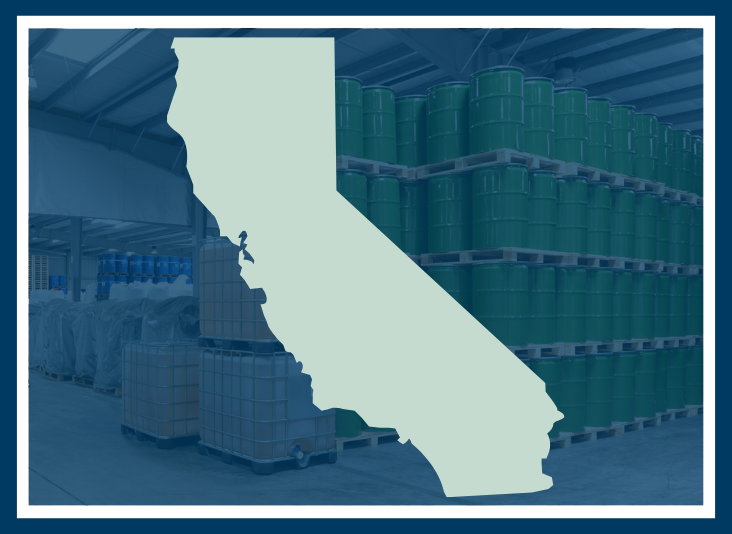
As of July 1, 2024, the California Department of Toxic Substances Control (DTSC) is adopting the Environmental Protection Agency’s (EPA’s) Generator Improvements Rule (GIR).
These changes will have a major impact on California waste generators—with monetary, regulatory, and safety implications for noncompliance. Don’t allow your organization to get left behind the regulatory wave—review the updates, summarized below, and make a plan for full compliance.
Phase 1 Rulemaking Updates
There are seven mandatory provisions in effect as of July 1, 2024:
- New re-notification requirements, ensuring safety and accountability. This includes that:
- Resource Conservation and Recovery Act (RCRA) Small Quantity Generators (SQGs) must re-notify, by September 1, every four years using EPA Form 8700-12. This starts in 2024.
- RCRA Large Quantity Generators (LQGs) must re-notify by March 1 of each even-numbered year. LQGs may submit their re-notification as part of their biennial report required under EPA 49 CFR 262.41.
- Additional labeling and marking requirements for containers and tanks to more clearly demonstrate risk. The only new update is that indications, or symbols, of the hazards of the contents of the tank or container must be added to each container. This is aligned with symbols used by the:
- Department of Transportation (DOT)
- Globally Harmonized System of Classification and Labelling of Chemicals (GHS)
- Occupational Safety and Health Administration (OSHA)
- Additional requirements for containers holding ignitable and reactive wastes for LQGs. LQGs must place “No Smoking” signs wherever there is a hazard from ignitable or reactive wastes. This is not just in central accumulation areas (CAAs), but anywhere these wastes are accumulated.
- Enhanced pre-transportation markings for containers to better portray information. Once the waste is in a CAA and prior to its shipment, waste containers must be marked with the applicable EPA hazardous waste codes that they will have for shipment. Examples include:
- D codes
- P codes, pure chemical waste formulations
- F codes, wastes from non-specific sources
- U codes, commercial-grade chemical waste formulations
- Closure regulations for LQGs, specifically in terms of EPA or authorized state notification. LQGs must notify the EPA or the authorized state using the site ID form (EPA form 8700-12):
- At least 30 days prior to facility closing
- Within 90 days after closing a facility
This applies to both facilities and waste accumulation units such as tanks, containers, or containment buildings.
- New requirements for incompatible waste storage within satellite accumulation areas (SAAs) to ensure safe storage and management within these small spaces. All incompatible wastes must be segregated by a berm or secondary containment apparatus. Containers that once held materials incompatible with the accumulating waste stream cannot be reused.
- New requirements for preparedness, prevention, and emergency procedures, including:
- Documenting arrangements with local authorities for full disclosure. SQGs and LQGs are now required to document their attempts to make arrangements with local authorities for the mitigation of emergencies.
- The creation of a quick reference guide (QRG) to summarize a LQG’s contingency plan. New LQGs must develop this guide, which should summarize their contingency plan for emergency responders. Existing LQGs must develop a QRG when revising their contingency plan.
These rules are meant to increase safety, accountability, and clarity for the management and transport of hazardous wastes. As this process progresses, the EPA plans to make additions and edits to the rule text, as well—which they have deemed as “Phase 2.”
Phase 2 Rulemaking
The second phase of this update process will encompass the addition and reorganization of regulations, including:
- Allowing Very Small Quantity Generators (VSQGs) to send their hazardous waste to LQGs for disposal
- Introducing a waiver to the 50-foot rule for accumulating ignitable and/or reactive wastes at LQG facilities
- Allowing generators to maintain their generator category during episodic generation
- Changing the term “Conditionally-Exempt Small Quantity Generator” (CESQG) to VSQG
- Adding new language for hazardous waste determination criteria
- Distinguishing between independent requirements and conditions for exemption
- Revisions to SAA requirements for SQGs and LQGs
- Reorganization of the regulations for improved user friendliness, specifically in reference to Section 66262.34, 66262.12, and Articles 3 and 4 of Chapter 15 of the GIR
- Adding new definitions for CAA, VSQG, LQG, and non-acute hazardous waste, as well as modifying the definitions of SQG and acute hazardous waste; These definitions can be found in 40 CFR 260.10 and 22 CCR 66260.10.
- Defining rules around mixing non-hazardous waste with hazardous waste
Hazardous Waste Safety and Compliance
Overall, these rule updates will increase safety, communication, accountability, as well as community and environmental health. While these rules may seem complex or difficult to implement, compliance is key—and those who don’t follow them will get left behind.
Looking for assistance with GIR compliance in this time of change and growth? Contact Triumvirate Environmental. Our team of operations support personnel and consultants are highly trained and up-to-date on the latest regulatory updates—meaning we can help you ensure safety and compliance, now and into the future.
- SEO Powered Content & PR Distribution. Get Amplified Today.
- PlatoData.Network Vertical Generative Ai. Empower Yourself. Access Here.
- PlatoAiStream. Web3 Intelligence. Knowledge Amplified. Access Here.
- PlatoESG. Carbon, CleanTech, Energy, Environment, Solar, Waste Management. Access Here.
- PlatoHealth. Biotech and Clinical Trials Intelligence. Access Here.
- Source: https://www.triumvirate.com/blog/ca-generators-ready-for-gir-updates
